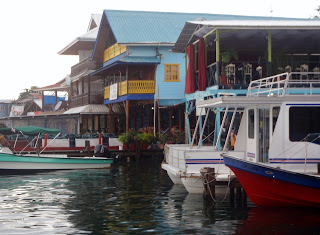When
Christopher Columbus arrived in Panama Main Street Bocas Town
 I was
awakened from my day dreaming by the sensation of pavement suddenly turning to
sand. No, we hadn’t gone off the road, we had arrived at Boca del Drago. A
short distance beyond the tourist restaurants, cabinas and gift shops there was
a small dock with a boat waiting to take me and a few fellow travelers over to
Playa de las Estrellas or
I was
awakened from my day dreaming by the sensation of pavement suddenly turning to
sand. No, we hadn’t gone off the road, we had arrived at Boca del Drago. A
short distance beyond the tourist restaurants, cabinas and gift shops there was
a small dock with a boat waiting to take me and a few fellow travelers over to
Playa de las Estrellas or 























